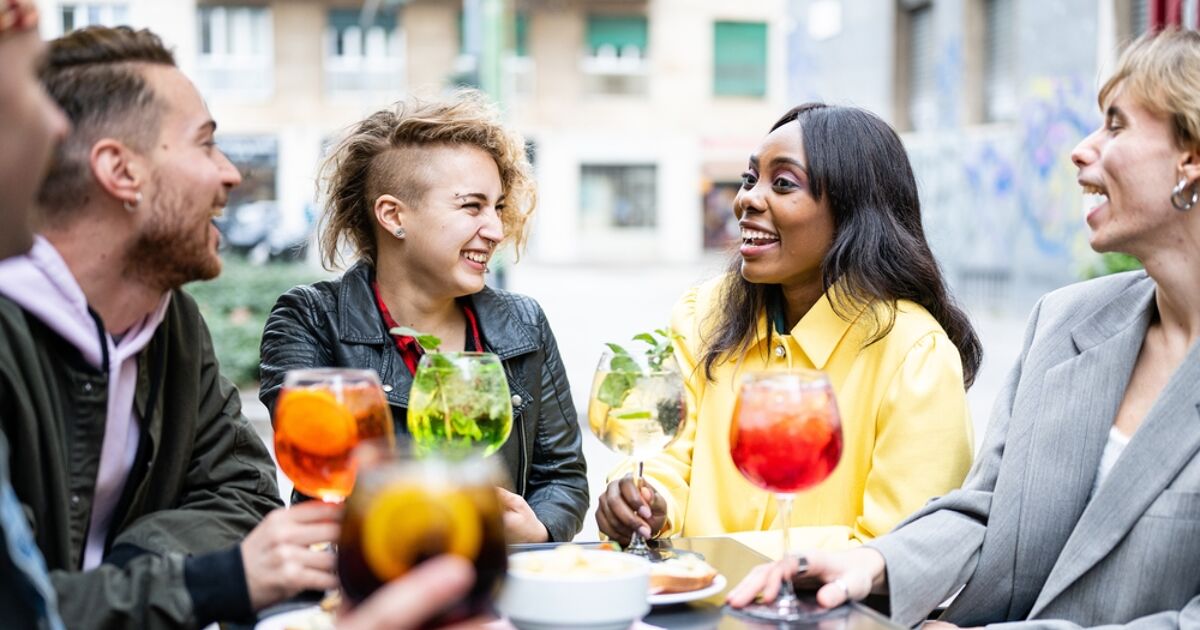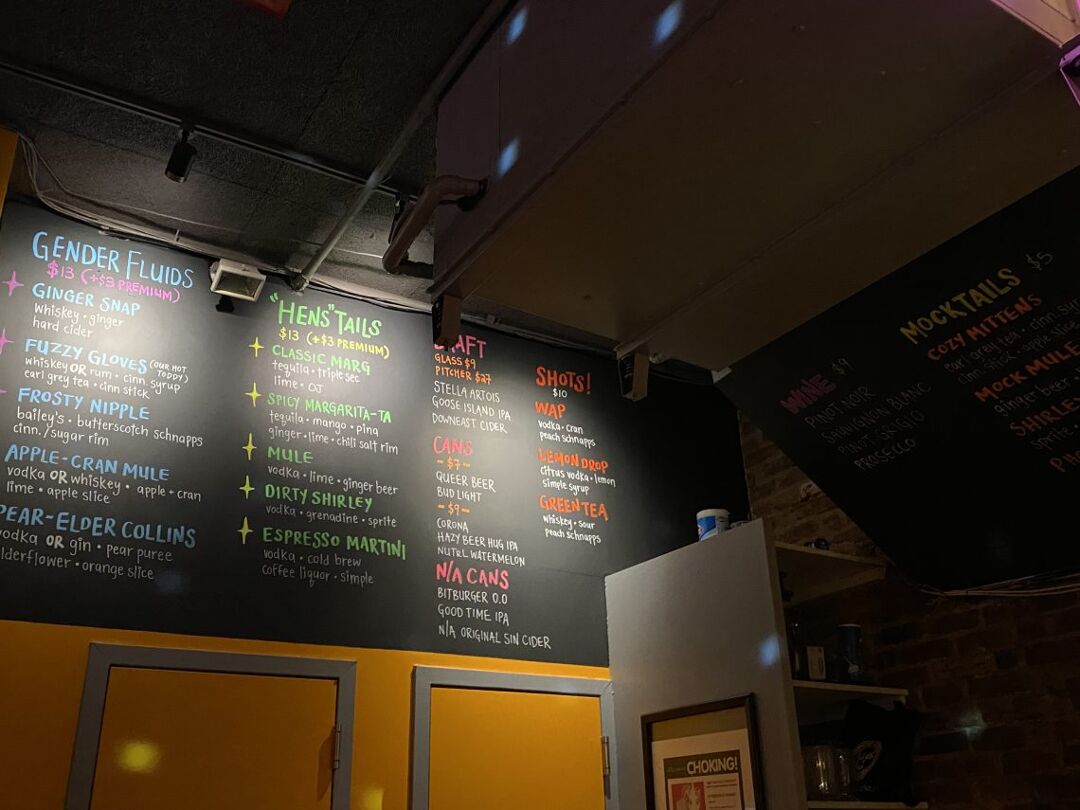
Henrietta Hudson is the oldest continuously running lesbian bar in the country. It sits in the midst of Greenwich Village on a quieter street, where it has been since 1991.
In that time, it has seen a lot of changes, including the legalization of same-sex marriage and the acceptance of gay relationships and people into mainstream culture. The clientele of Henrietta Hudson skews more Gen Z due to several factors, including its proximity to New York University.
It’s a generation that came of age without any bars to go to. And the effect of that is so immediately obvious and so crazy, because they don’t know how to go to bars.
Another change that Henrietta Hudson has seen? Gen Z drinks a whole lot less than those who came before them.
Never Miss a Beat
Subscribe to our newsletter to stay ahead of the latest LGBTQ+ political news and insights.
Subscribe to our Newsletter today
Gaby, a manager who works at Henrietta Hudson (she/they pronouns), tells me about how she started working coat-check in the space three years ago and has worked their way up. She describes the bar as “home” when I ask about their relationship to Henrietta’s.
Under the scattered shadows of a disco ball and the glowing pink lights of the Henrietta Hudson sign, Gaby tells me how they’ve seen the patrons grow and change in a way only someone with a front-row seat to the comings and goings of a lesbian bar could: people who tell her they may be bicurious going on to their first date at Henrietta Hudson, lesbian situationships going down on the dance floor, first kisses and breakups, a couple who told Gaby they’re starting IVF soon.
Related
Dozens of women’s sports bars are opening in the US as interest grows exponentially
The Sports Bra in Portland started the latest trend in America’s bar scene.
Gaby has personally seen the increase in sobriety among young people.
“A lot of my regulars come in and they actually order non-alcoholic beverages or just sodas, soda waters,” they say. Gaby says that on any given day, about 10 to 15% of the orders they get are non-alcoholic drinks, whether it’s a club night or just a regular night.
Across the country, Olga owns Doc Marie’s, a lesbian bar in Portland, Oregon. She has noticed the same thing. “In terms of alcohol consumption, I have absolutely seen that trend,” she said about Gen Z drinking less, though she stipulates that she can only speak to her own individual bar.
Research from Gallup is in agreement with both: studies show that fewer than four in 10 young adults (38%) are regular drinkers, a sharp contrast from 20 years ago, when Henrietta Hudson opened. Then, younger adults were the most likely to be regular drinkers. Still, the majority of Americans still drink, with 62% of U.S. adults reporting they ever drink alcohol, but a sizable chunk – 38% – abstaining completely.
“It is becoming clear that, for whatever reasons, today’s younger generations are just less interested in alcohol and are more likely than older generations to see it as risky for their health,” said Director of the National Institute on Alcohol Abuse and Alcoholism George F. Koob in a statement to Time.
Part of the rise in sobriety, particularly for a younger generation, could be because of the legalization of cannabis, Gaby suggested.
“There’s a lot of people that just don’t really subscribe with drinking alcohol as a means to having fun, and whether that means that they look to weed, or maybe they just look to not drinking at all,” says Gaby.
Another more worrying cause could be that younger people simply spend less time with their friends in general. Since going out to bars is almost always a social activity, it would follow that Gen Z would drink less as a result. Time article reported that, on average, the amount of time people spent with friends in person decreased from 30 hours a month in 2003 to 10 hours a month in 2020, with people ages 15 to 24 experiencing the most decline.
With a younger generation that is increasingly isolated and sober-curious, and the surgeon general under former President Joe Biden calling for cancer warnings on alcohol, how are lesbian bars – a potentially dying breed – changing to meet the current moment?
The answer, according to Olga, is events, a strategy that came out of the pandemic.
“Our event schedule was something that was also born out of this new way that everyone is going out post-pandemic. Especially in the very beginning, people were going out very intentionally and a lot less,” she explains.
As a result, Doc Marie’s programming schedule now features an event pretty much every day, sometimes two. A glance at their calendar shows platonic friend mixers, cocktail classes, and tarot readings, along with more conventional events like “queeraoke” and trivia nights.
“That was definitely born out of necessity in the beginning, and then it just became how we function,” says Olga. “And I feel like it’s how a lot of bars function, especially places like queer places that serve a smaller population where they need to draw people out more.”
I think it can be scary for a business when, obviously, when you sell cocktails, you can sell them at a higher cost than just a soda or soda water. As a business, you do want to be a center [for the community], but you also have to survive.
Gaby from Henrietta Hudson echoes this sentiment. “There’s a lot of events that happen here that are not necessarily centered around drinking. We’ll have clubs that come in, and they’ll be like, hey, sometimes we meet up to do dodgeball, and then we come here and we have a drink, but it doesn’t necessarily have to be an alcoholic beverage,” they say.
Gaby says that the director of operations and the owner of Henrietta Hudson are sober. Olga is as well. So both bars have management that prioritizes offering options to those who don’t drink but still want to go out to bars.
“We have a mocktail menu, and we put it right in with the rest of the menu, so it’s not super alienating to order a non-alcoholic drink,” Gaby says. Alongside classic non-alcoholic soft drinks, Henrietta Hudson also offers “phony negronis” (exactly what they sound like), a mock mule, as well as seasonal drinks like “a cozy mitten,” which is Earl Grey tea with a cinnamon stick, cinnamon syrup, and an apple wedge. Doc Marie’s goes further with several mocktails that feature non-alcoholic spirits, such as a lavender lemon drop (lemon, lavender syrup, and a non-alcoholic gin) or The Hermit (a non-alcoholic tequila with passionfruit, black pepper, and simple syrup).
At both bars, these are integrated into the menu rather than into a separate non-alcoholic menu, which Gaby tells me is intentional. “We put the mocktails right in with the rest of the menu, so it’s not super alienating, because sometimes it can be intimidating when you’re not drinking to be in a place full of people who are.”

Olga explains that many young people who came of age during COVID aren’t as familiar with drinking culture. “It’s a generation that came of age without any bars to go to. And the effect of that is so immediately obvious and so crazy, because they don’t know how to go to bars,” Olga says.
“And that is a neutral statement. It’s not positive or negative, but people will come in all the time in their early 20s, and they just have no concept of the rhythm and process and nature of bar-going.”
Olga says that she has started getting her bartenders to train younger patrons in bar-going. For example, they explain what a tab is, when to open and close one, or when it’s appropriate to do a puzzle or read a book (not during a DJ set, as Olga says one younger person did).
Despite these strategies, the decline in drinking can still affect the bottom line.
“I think it can be scary for a business when, obviously, when you sell cocktails, you can sell them at a higher cost than just a soda or soda water. As a business, you do want to be a center [for the community], but you also have to survive. You got to pay rent,” says Gaby.
“But,” they add, “for us, people, safety and comfortability outweigh possible profits, or the encouragement of binge drinking, because that’s dangerous enough.”
“I think it’s more important in this space and in other queer spaces, where we have a community of people who can be vulnerable, to make sure they don’t leave the bar wasted,” Gaby explains.
Olga isn’t really worried about the trend of people drinking less because “alcohol sales are still really, really high and definitely the majority.”
“Of course, money is tied into everything that we do, and Doc Marie’s very much needs to remain open,” she says. Doc Marie’s non-alcoholic options are made with high-quality ingredients, so they can be priced similarly to alcoholic drinks. They are “sourced and created to be an equal value to an alcoholic drink.”
Olga says Gen Z’s drinking less is an objectively positive trend in terms of health. “Gen Z, using broad terms, does not have the same relationship with going out that me and my peers had when I was 21 and 22 – like that was about going hard.”
“And here, it’s a lot about moderation and health, and I love that so much. Like, that’s what I want to encourage and foster that as much as I can.”
Subscribe to the LGBTQ Nation newsletter and be the first to know about the latest headlines shaping LGBTQ+ communities worldwide.